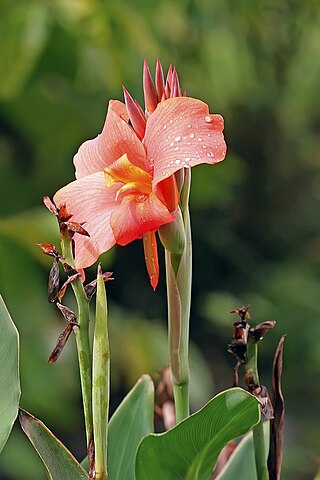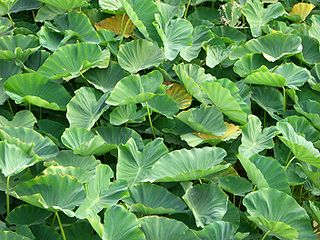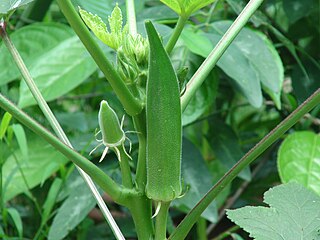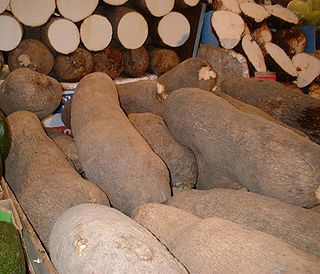Arrowroot is to an edible starch obtained from several tropical plants.
Contents
Arrowroot may also refer to:
Arrowroot is to an edible starch obtained from several tropical plants.
Arrowroot may also refer to:

Manihot esculenta, commonly called cassava, manioc, or yuca, is a woody shrub of the spurge family, Euphorbiaceae, native to South America. Although a perennial plant, cassava is extensively cultivated as an annual crop in tropical and subtropical regions for its edible starchy tuberous root, a major source of carbohydrates. Though it is often called yuca in parts of Spanish America and in the United States, it is not related to yucca, a shrub in the family Asparagaceae. Cassava is predominantly consumed in boiled form, but substantial quantities are used to extract cassava starch, called tapioca, which is used for food, animal feed, and industrial purposes. The Brazilian farinha, and the related garri of West Africa, is an edible coarse flour obtained by grating cassava roots, pressing moisture off the obtained grated pulp, and finally drying it.

Canna or canna lily is the only genus of flowering plants in the family Cannaceae, consisting of 10 species. Cannas are not true lilies, but have been assigned by the APG II system of 2003 to the order Zingiberales in the monocot clade Commelinids, together with their closest relatives, the gingers, spiral gingers, bananas, arrowroots, heliconias, and birds of paradise.

Colocasia is a genus of flowering plants in the family Araceae, native to southeastern Asia and the Indian subcontinent. Some species are widely cultivated and naturalized in other tropical and subtropical regions.

Maranta arundinacea, also known as arrowroot, maranta, West Indian arrowroot, obedience plant, Bermuda arrowroot, araru, araruta, ararao or hulankeeriya, is a large, perennial herb found in rainforest habitats. Arrowroot flour is now produced commercially mostly in St. Vincent and the Grenadines. Arrowroot was one of the earliest plants to be domesticated for food in northern South America, with evidence of exploitation or cultivation of the plant dating back to 8200 BCE.

Root vegetables are underground plant parts eaten by humans as food. Although botany distinguishes true roots from non-roots, the term "root vegetable" is applied to all these types in agricultural and culinary usage.

Dioscorea alata, also known as purple yam, ube, or greater yam, among many other names, is a species of yam. The tubers are usually a vivid violet-purple to bright lavender in color, but some range in color from cream to plain white. It is sometimes confused with taro and the Okinawa sweet potato, although D. alata is also grown in Okinawa, where it is known as beniimo (紅芋). With its origins in the Asian tropics, D. alata has been known to humans since ancient times.

The Marantaceae are a family, the arrowroot family, of flowering plants consisting of 31 genera and around 530 species, defining it as one of the most species-rich families in its order. Species of this family are found in lowland tropical forests of Africa, Asia, and the Americas. The majority (80%) of the species are found in the American tropics, followed by Asian (11%) and African (9%) tropics. They are commonly called the prayer-plant family and are also known for their unique secondary pollination presentation.

Arum maculatum is a woodland flowering plant species in the family Araceae. It is native across most of Europe, as well as Turkey and the Caucasus.

Taro is a root vegetable. It is the most widely cultivated species of several plants in the family Araceae that are used as vegetables for their corms, leaves, and petioles. Taro corms are a food staple in African, Oceanic, and South Asian cultures. Taro is believed to be one of the earliest cultivated plants.

Okra or Okro, Abelmoschus esculentus, known in many English-speaking countries as ladies' fingers or ochro, is a flowering plant in the mallow family. It has edible green seed pods. The geographical origin of okra is disputed, with supporters of West African, Ethiopian, Southeast Asian, and South Asian origins. Cultivated in tropical, subtropical, and warm temperate regions around the world, okra is used in the cuisines of many countries.

Cocoyam is a common name for more than one tropical root crop and vegetable crop belonging to the Arum family and may refer to:

Canna indica, commonly known as Indian shot, African arrowroot, edible canna, purple arrowroot, Sierra Leone arrowroot, is a plant species in the family Cannaceae. It is native to much of South America, Central America, the West Indies, and Mexico. It is also naturalized in the southeastern United States, and much of Europe, sub-Saharan Africa, Southeast Asia, and Oceania. Canna indica has been a minor food crop cultivated by indigenous peoples of the Americas for thousands of years.

Yam is the common name for some plant species in the genus Dioscorea that form edible tubers. Yams are perennial herbaceous vines cultivated for the consumption of their starchy tubers in many temperate and tropical regions, especially in West Africa, South America and the Caribbean, Asia, and Oceania. The tubers themselves, also called "yams", come in a variety of forms owing to numerous cultivars and related species.

Tacca leontopetaloides is a species of flowering plant in the yam family Dioscoreaceae. It is native to Island Southeast Asia but have been introduced as canoe plants throughout the Indo-Pacific tropics by Austronesian peoples during prehistoric times. They have become naturalized to tropical Africa, South Asia, northern Australia, and Oceania. Common names include Polynesian arrowroot, Fiji arrowroot, East Indies arrowroot, and pia.
The Canna Agriculture Group contains all of the varieties of Canna used in agriculture. Canna achira and Canna edulis are generic terms used in South America to describe the cannas that have been selectively bred for agricultural purposes, normally derived from C. discolor. It is grown especially for its edible rootstock from which starch is obtained, but the leaves and young seed are also edible, and achira was once a staple foodcrop in Peru and Ecuador.

Maranta is a genus of flowering plants in the family Marantaceae, native to tropical Central and South America and the West Indies. Maranta was named for Bartolomeo Maranta, an Italian physician and botanist of the sixteenth century.
Florida arrowroot was the commercial name of an edible starch extracted from Zamia integrifolia (coontie), a small cycad native to North America.

Goeppertia allouia, known as lerén or lairén in Spanish, and also known in English as Guinea arrowroot, and sweet corn root, is a plant in the arrowroot family, native to northern South America and the Caribbean, The name "allouia" is derived from the Carib name for the plant Leren is a minor food crop in the American tropics, but was one of the earliest plants domesticated by pre-historic Amerindians in South America.
Arrowroot is a starch obtained from the rhizomes (rootstock) of several tropical plants, traditionally Maranta arundinacea, but also Florida arrowroot from Zamia integrifolia, and tapioca from cassava, which is often labeled arrowroot. Polynesian arrowroot or pia, and Japanese arrowroot, also called kudzu, are used in similar ways.

Uraró, also known as araró or arrowroot cookies, are Filipino cookies made from arrowroot flour. They have a dry and powdery texture and are usually flower-shaped. They originate from the Tagalog people of southern Luzon, particularly in the provinces of Laguna, Quezon, and Marinduque.